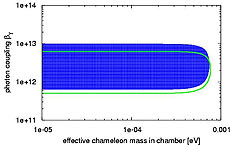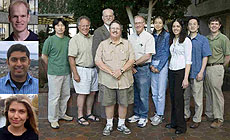A probe of the particle nature of dark energy

The image shows the region excluded at the 99.5 percent confidence level by the GammeV chameleon search. The vertical axis is the chameleon/photon coupling constant and the horizontal axis is the effective chameleon mass inside the vacuum chamber. The solid blue region is for scalar chameleons while the outline region is for pseudoscalar chameleon particles.
The GammeV collaboration has wrapped up the second component of their
experimental suite; a test of chameleon dark energy. This is the first
dedicated-laboratory test of a dark-energy model, and it is a test that fits
on the top of a table (albeit a long, narrow one).
These results, appearing in the Jan. 23 issue of Physical Review Letters, come on the heels of the GammeV
search for axion-like particles. That result was published in PRL last year (PRL
100 080402) and in Fermilab Today.
In the chameleon dark-energy model, the observed acceleration of the
universe is caused by a light, spin-zero particle that evades other
experiments. This evasion is due to the fact that the
properties of the hypothetical chameleon particle---namely its mass---depend upon the
environment, hence the chameleon moniker. GammeV collaborators exploit this effect to trap these chameleon particles in
a jar-like vacuum chamber.
Collaborators generate chameleon particles by interacting polarized laser light with a magnetic field. Some of the photons oscillate into chameleon particles, which pass through the jar but bounce off of the walls of the vacuum
chamber---including the optical windows at each end. When the laser is
turned off, the jar empties as the chameleons reconvert to detectable
photons. This afterglow is a telltale signature of the chameleon
particle.
Planned alongside the axion-like particle search, the chameleon particle
search required only a rearrangement of the components of the apparatus.
The GammeV scientists, including two theorists who study chameleon
cosmology, worked with the technical staff in the Particle Physics
Division and at the Magnet Test Facility to collect the 20 hours of data
needed to probe the unexplored landscape of particle dark energy.
While no signal was found, the resulting limits constrain the properties
of the chameleon particle, including its coupling to photons and its mass,
for a range of chameleon dark-energy models. Moreover, with the lessons
learned from this experiment, the GammeV collaboration is designing an
upgrade that will probe a significantly broader range of dark-energy
models as well as general chameleon, spin-zero field models over a much larger
range of the available parameter space. More information about the GammeV
experiment can be found at http://gammev.fnal.gov.

Top left: Jason Steffen; Center left: Amol Upadhye; Bottom left: Amanda Weltman. Left to right: Jonghee Yoo, Dick Gustafson, Peter Mazur, Al Baumbaugh, Ray Tomlin, Xi Yang, Yilda Irizarry-Valle, Aaron Chou and William Wester.
|